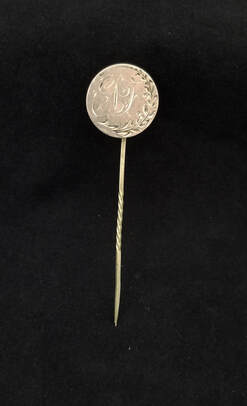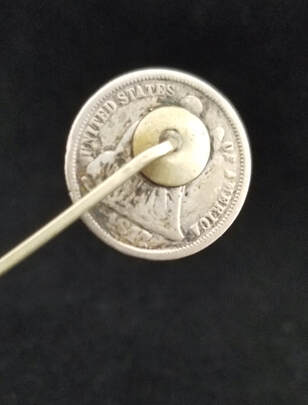|
An interesting phenomenon of the 19th century was the popularity of "love tokens". Although they had been around long before, the love token became an enormous fad both in England and America in the second half of the 19th century. At their most basic, they were a small item, typically a smoothed coin, mounted on a stick pin or hat pin and engraved with initials, meaningful designs, etc. Many, if not most, love tokens were simply made affairs... often done by roadside craftsmen who would produce desired pieces in short order.
Love tokens were used for a variety of purposes... many would have the initials of a loved one and often times would serve as a de facto engagement ring for those that could not afford one. Others would be given to departing spouses or other family members headed to sea, military deployments, etc. Still others served as mourning jewelry items. The latter purpose was tied directly to the Victorian fascination with mourning, encouraged in large measure by Queen Victoria's decades-long mourning for Prince Albert. The popularity of love tokens arguably reached its zenith in the period 1860-1890. In America, they became so popular during those decades that it caused a noticeable shortage of dimes for a period of time (dimes were evidently the most popular coins to make into a love token). Their popularity waned with the end of the Victorian era, however, and today they are largely a historic curiosity. There is a popular collector base for them, however, and today you can expect to pay between $25 and $100 for the average love token. Comments are closed.
|
AuthorBryan H. Roberts is a professional appraiser in Sarasota, FL. He is a member of the Florida State Guardianship Association and currently serves on the board of the local FSGA chapter. He is a past president of the Sarasota County Aging Network, a non-profit that provides grants to other non-profits benefiting seniors in need and is also a board member of PEL, an area non-profit whose resale store profits support programs and scholarships for at-risk and disadvantaged youth. He is certified in the latest Uniform Standards of Appraisal Practice (USPAP) Equivalent Archives
May 2024
Categories |



 RSS Feed
RSS Feed